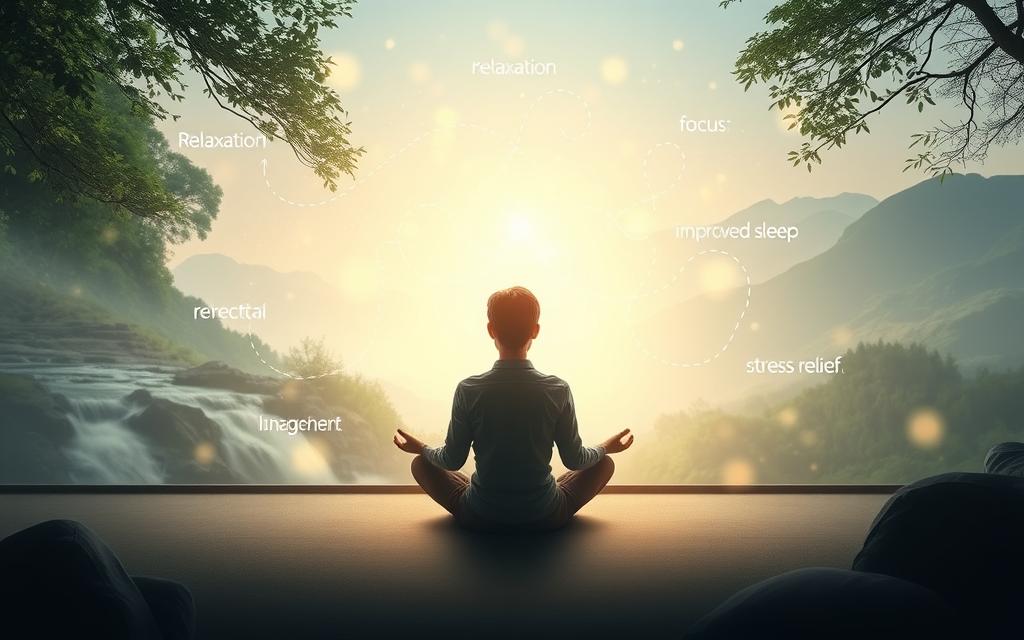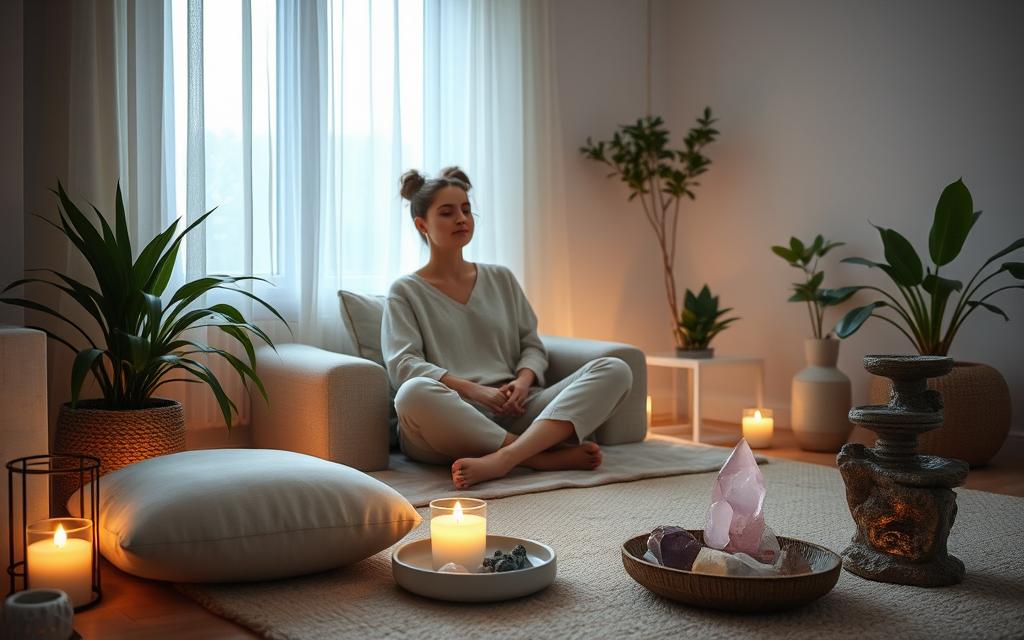Ever thought about using your mind to change your life? Self-hypnosis is the key. This guide will show you how to use your own mind to change your life for the better.
Self-hypnosis is a deep relaxation that lets you reach your subconscious. Here, you can make big changes. It helps you face challenges, improve your skills, and reach your dreams. But how does it work, and how can it help you every day?
Get ready to discover yourself through self-hypnosis. You’ll learn to unlock your mind’s full power. And you’ll see how it can change your life in amazing ways.
Understanding the Fundamentals of Self-Hypnosis
Self-hypnosis is a powerful tool that lets you enter a trance-like state. This state boosts your focus and lets you tap into your subconscious mind. By doing so, you can use trance induction methods and subconscious mind programming to change your life for the better.
Defining Self-Induced Trance States
When you practice self-hypnosis, your mind goes into an alpha or theta state. This state is all about deep relaxation and being open to suggestions. It’s a time when you can reach your inner strength, face your fears, and set goals for yourself.
The Science Behind Mental Programming
Studies show that hypnosis changes how your brain works. It affects brain activity, blood flow, and how different parts of your brain talk to each other. This means self-hypnosis can help you face challenges, do better in what you do, and feel more positive.
Breaking Common Misconceptions
- Self-hypnosis isn’t about losing control or magic tricks. It’s a skill you can learn and use to control your thoughts and feelings.
- Hypnosis isn’t sleep or being unconscious. It’s a focused state where you’re open to good suggestions.
Learning self-hypnosis can open doors to personal growth and change. By understanding it and clearing up myths, you can unlock your subconscious mind. This way, you can create the life you’ve always wanted.
How Self-Hypnosis Works: The Brain-Mind Connection
Self-hypnosis connects the brain and mind in a powerful way. It makes the brain focus and ignore outside distractions. This lets people change their thoughts and actions with visualization and positive words.
Research shows self-hypnosis can make you feel very relaxed. You feel like you’re watching yourself from outside. This lets you accept suggestions without questioning them. It’s why self-hypnosis works in hospitals and helps people change their lives.
The science behind self-hypnosis is about hypnotic suggestions. It changes your subconscious mind to reach your goals. This mind over matter idea uses the law of attraction to guide you towards success.
To do self-hypnosis, find a quiet place and relax. Count down, imagine good things happening, and wake up slowly. This makes your brain respond in amazing ways, like making your heart beat faster without moving.
Self-hypnosis is a strong tool for many problems, like pain and anxiety. With the right help, you can use self-hypnosis to reach your dreams and goals.
The Historical Evolution of Self-Hypnosis Practices
The roots of self-hypnosis go back to ancient meditation. But, the modern version has changed a lot over time. The 19th century was key in making self-hypnosis a science-backed practice.
Ancient Origins and Modern Development
In 19th-century France, pharmacist Emile Coué and doctor Ambroise-Auguste Liébault started it all. They created “conscious autosuggestion,” where people could hypnotize themselves. They used self-suggestions and imagination.
Coué’s famous saying was: “Every day, in every way, I am getting better and better.” He suggested saying it 20 times a night.
Scientific Recognition and Research
Research has shown self-hypnosis works well for many things. It helps with hypnosis for self-improvement and self-hypnosis techniques. It can help with pain, anxiety, sleep, and even improve performance.
By using self-hypnosis, people can improve their lives. They can take control of their well-being.
Self-hypnosis can lower physical pain and anxiety. It gives patients a way to manage pain on their own. Even when doctors aren’t there.
It helps patients control pain from medical procedures. They can think positive thoughts and remember happy times.
Key Benefits of Self-Hypnosis in Modern Life
In today’s fast world, self-hypnosis is a key tool for growth and well-being. It taps into the subconscious mind, offering many benefits for life.
Self-hypnosis helps reduce stress and promotes relaxation. 76% of participants in a meta-analysis saw better depression symptoms through hypnosis. Also, a review of six studies found positive changes in anxiety traits through self-hypnosis.
It also benefits physical health. A meta-analysis of 18 studies showed 75% of participants had significant pain relief through hypnosis. Nearly 70% of participants also saw better sleep, with 58.3% noticing improvements right away.
- Improved focus and concentration
- Enhanced self-confidence and self-esteem
- Effective management of unwanted habits, such as smoking or overeating
- Increased resilience and adaptability in the face of life’s challenges
By using the subconscious mind, people can unlock the full potential of self-hypnosis for self-improvement. They can reach their goals with more ease and confidence.

Looking to manage stress, improve sleep, or boost well-being? Self-hypnosis is a versatile and effective solution. By adding it to your daily routine, you can lead a healthier, happier, and more fulfilling life.
The Difference Between Self-Hypnosis and Traditional Meditation
Self-hypnosis and traditional meditation both help us relax. But they use different methods and aim for different results. Self-hypnosis helps us enter a trance state to reach our subconscious mind. It uses hypnotic visualization and trance induction methods. Traditional meditation, by contrast, focuses on being mindful and aware of the present moment. It aims to calm our minds and lower stress levels.
Comparing Techniques and Outcomes
Self-hypnosis is more focused, helping us tackle specific issues like pain management, anxiety, and behavioral change. Meditation, on the other hand, seeks a broader state of relaxation and peace. It doesn’t aim for specific goals.
Unique Aspects of Self-Hypnotic States
- Self-hypnosis empowers us to control our healing journey.
- Research shows it greatly helps pregnant women, easing pain, fear, and anxiety during labor.
- Yet, not everyone finds self-hypnosis easy. Some prefer guided meditation or hypnotherapy.
Both self-hypnosis and meditation offer unique benefits for our mental and physical health. The choice between them depends on our personal preferences, goals, and how we respond to each.
Essential Components of Successful Self-Hypnosis
Mastering self-hypnosis needs a mix of key elements. To see real changes, you must understand hypnotic suggestions and subconscious mind programming well.
The main parts for good self-hypnosis are:
- Relaxation: Getting into a deep relaxed state is key. It lets you focus inside without distractions.
- Focus: Keeping your mind sharp and focused is vital. It helps you connect with your subconscious.
- Visualization: Using your mind to picture things clearly is powerful. It helps you build positive thoughts.
- Positive Suggestions: Saying empowering things to yourself can change your mind. These should match what you want to achieve.
Also, having clear goals, a good place to practice, and regular practice are important. By getting these right, you can use hypnotic suggestions and subconscious mind programming to improve your life.

Preparing Your Mind and Environment for Self-Hypnosis
Starting your self-hypnosis journey requires the right setup. You need a good physical and mental space. This setup can make your self-hypnosis practice more effective.
Creating the Optimal Setting
To dive into self-hypnosis, find a quiet, comfy spot. Trance induction methods need your full attention. So, avoid any distractions.
- Look for a private, calm place where you won’t get interrupted.
- Make sure the room is dim and the temperature is just right.
- Get rid of distractions like phones, loud noises, or bright lights.
- Try calming self-hypnosis techniques like soft music or scents to improve the mood.
Mental Preparation Techniques
Getting your mind ready for self-hypnosis is key. Certain mental exercises can help you reach a deeper state of focus.
- Try progressive muscle relaxation to relax your body and mind.
- Use deep breathing exercises to calm down and get into a meditative state.
- Imagine a specific trance method or focus on one thing to help you concentrate.
- Have clear goals and affirmations for your session to guide your intentions.
With careful preparation of your mind and space, you’re ready to explore the power of self-hypnosis.
Step-by-Step Guide to Self-Hypnosis Induction
Learning self-hypnosis can open doors to personal growth, relaxation, and change. Start your journey with this guide. It explains how self-hypnosis works and the methods for entering a trance state.
- Find a comfortable position. Sit or lie down in a quiet, distraction-free spot. Make sure your body is relaxed and supported.
- Relax your body. Use progressive muscle relaxation. Tense and release each muscle group to relax deeply.
- Focus on your breath. Breathe slowly and deeply. Let your belly rise and fall with each breath.
- Induce a trance state. Gently focus inward, letting your mind be present. Imagine a peaceful scene or going down a staircase to enter a trance.
- Introduce positive suggestions. While in trance, say affirmations or imagine achieving your goals. This can help you make positive life changes.
- Gradually return to normal awareness. Slowly count back from 10 to 1. Feel more alert and refreshed with each number. Stretch and open your eyes to end the session gently.
Practice regularly to master self-hypnosis. With time and effort, you’ll enter a trance state more easily. Use it to improve your well-being and reach your goals.

Advanced Self-Hypnosis Techniques for Deep Trance States
Mastering advanced self-hypnosis techniques can deepen the trance state. These methods use hypnotic visualization and subconscious mind programming. They help change thoughts, behaviors, and emotions deeply.
Visualization exercises are a key method. They create vivid mental images that engage the senses. This helps the mind relax and focus deeply. Hypnotic visualization can include peaceful scenes or imagining success.
Using anchors is another technique. Anchors are specific stimuli that trigger certain mind states. By linking a gesture, sound, or image with a feeling, you can access those states easily. This makes self-hypnosis more effective.
Neuro-linguistic programming (NLP) also enhances self-hypnosis. NLP techniques like reframing and using metaphors change thought patterns. They help reprogram the mind at a deep level.
Learning these advanced techniques unlocks the mind’s power. They help achieve personal growth, healing, and transformation.
Success in self-hypnosis depends on mindset and perseverance. Keeping a clear intention and being open to the process leads to better results. This way, the unconscious mind can create lasting positive changes.
Common Applications and Uses in Daily Life
Self-hypnosis is a versatile tool for our daily lives. It helps with stress management and relaxation, performance enhancement, and habit modification. This technique offers many benefits.
Stress Management and Relaxation
Self-hypnosis is great for managing stress and anxiety. It helps people relax deeply, quiet their minds, and feel better. Just 3-5 minutes of self-hypnosis can make you calmer and more focused.
Performance Enhancement
Self-hypnosis can also boost performance in many areas. It helps with school, sports, public speaking, and creativity. By using positive affirmations and visualizations, you can overcome mental blocks and reach your full potential.
Habit Modification
Self-hypnosis is also useful for changing habits and behaviors. It can help with addictions, phobias, and fears. By changing your subconscious mind, you can make lasting changes and improve your life.
Self-hypnosis is a valuable tool for personal growth. It helps with stress, performance, and habit changes. This natural technique can greatly improve your well-being.

Understanding the Limitations and Potential Risks
Self-hypnosis techniques are powerful, but knowing their limits and risks is key. Hypnosis, including self-hypnosis, is safe when done with a trained expert. Yet, there are a few things to remember.
Not everyone can easily get into a deep trance during self-hypnosis. Some might feel a bit disoriented or struggle to relax and focus. This can make self-hypnosis less effective for some.
Also, don’t use self-hypnosis instead of seeing a doctor or therapist. For serious mental health issues like schizophrenia or substance abuse, hypnosis might not be right. It could even make things worse.
Remember, hypnosis can bring up memories of past traumas. This can lead to false memories. People with trauma history should be careful and talk to a doctor before trying self-hypnosis.
Despite these challenges, self-hypnosis techniques can help with stress, pain, and behavior issues. Still, it’s wise to talk to a healthcare professional before starting. This is true if you have any health concerns.
Knowing the risks and limits of self-hypnosis helps you use it wisely. With the right preparation and guidance, it can be a powerful tool for personal growth.
Integrating Self-Hypnosis into Your Daily Routine
Adding self-hypnosis to your daily life can change you for the better. It’s all about making it a regular part of your routine. This is how you unlock its true power.
Begin by setting aside 15-30 minutes each day for self-hypnosis. Being consistent is key. It helps make the positive changes you want stick. Try mixing self-hypnosis with meditation or journaling for a well-rounded routine.
While practicing self-hypnosis, aim to match your subconscious thoughts with your goals. Use vivid images and positive sayings to change your mindset. This can help you overcome bad habits and improve in many areas of life, like handling stress or boosting performance.
- Dedicate 15-30 minutes daily to self-hypnosis practice
- Combine self-hypnosis with other mindfulness exercises for a holistic approach
- Focus on aligning subconscious beliefs with conscious goals
- Leverage visualization and affirmations to reprogram your mind
- Experience the transformative power of self-hypnosis in your personal and professional life
Adding self-hypnosis to your daily routine can unlock your full potential. It’s a powerful tool for reaching your goals. Start this journey of self-discovery and personal growth today.

Conclusion
Self-hypnosis is a powerful tool for personal growth and self-improvement. It offers many benefits for both mental and physical health. By learning how self-hypnosis works, people can tap into their subconscious mind. This helps them reach their goals and improve their life quality.
The benefits of self-hypnosis include managing stress, relaxing, improving performance, and changing habits. Research shows it helps with quitting smoking, losing weight, and managing pain. It also boosts self-esteem and confidence, leading to personal transformation.
As more people learn about self-hypnosis, it’s important to use it wisely. Always seek help from experts, if needed. With dedication, practice, and belief, self-hypnosis can become a daily part of life. It can greatly enhance well-being and personal growth.
